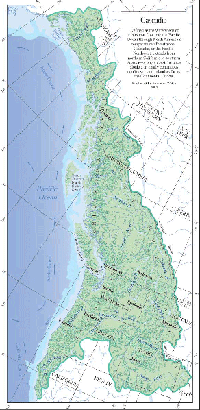--Wendell Berry |
Living Awareness Institute:
What are bioregions?Bioregions are unique life-places with their own soils and land forms, watersheds and climates, native plants and animals, and many other distinct natural characteristics. Each characteristic affects the others and is affected by them as in any other living system or body. People are also an integral part of life-places. What we do affects them and we are in turn affected by them. The lives of bioregions ultimately support our own lives, and the way we live is becoming crucial to their ability to continue to do so.
Bioregionalism is a fancy name for living a rooted life. Sometimes called "living in place," bioregionalism means you are aware of the ecology, economy and culture of the place where you live, and are committed to making choices that enhance them . A bioregion is an area that shares similar topography, plant and animal life, and human culture. Bioregions are often organized around watersheds, and they can be nested within each other. Bioregional boundaries are usually not rigid, and often differ from political borders around counties, states, provinces and nations. Ideally, bioregions are places that could be largely self-sufficient in terms of food, products and services, and would have a sustainable impact on the environment. Living a bioregionally-conscious life means making choices daily that focus on local ecology, economy and culture. It may mean any or all of the following:
Bioregional eatingFood is a basic necessity of life. One of the highest-impact actions you can take is to buy food grown locally and organically whenever you can.If you live in a place that doesn't have a year-round growing season (most of the U.S.), ask yourself if you really need to eat lettuce or fresh strawberries in December, or if you could enjoy feasting on vebetables and fruits from the root cellar and locally-grown food frozen, canned or dried from the summer's harvest. Eating a diet appropriate to the climate not only avoids the costs and damage of transporting food; it is also healthful and wise. Community Supported AgricultureOne way to get the best locally produced food is to join a Community Supported Agriculture (CSA) farm. You pay up front to buy a "share," usually in late winter or early spring when the farmer is getting ready to plant, and you get weekly deliveries of vegetables throughout the growing season. Most CSA farms have mainly vegetables; others also have eggs, milk, chicken, beef, flowers or honey. You get great, organically grown local food, and the satisfaction of supporting a sustainable agriculture movement that protects the land and provides a farmer with a living.CSA farms also offer opportunities to visit, share in the work and take part in celebrations at planting, harvest, full moons or solstices. These experiences are invaluable for city dwellers, whose everyday life is far from the land, and children, who may think food originates in a supermarket. CSA membership provides a connection to the land, the seasons and the basic, fundamentally important work of growing food. Living bioregionally doesn't mean, however, that a northern dweller could never again eat bananas, grapefruit or kiwi, or lettuce, spinach and tomatoes in winter. The bioregional vision includes local greenhouses, solar-heated, in which such warm-weather foods could be grown. Amory and Hunter Lovins are demonstrating how well this idea can work in their mountaintop home in the Colorado Rockies, the Rocky Mountain Institute.
Bioregionalism is not about deprivation or severely limiting your choices. It's about making sure that the choices you make strengthen your local ecology, economy and culture rather than harming them.
Isn't local culture a bit provincial, though?The idea of "local culture" and "local economics" and "supportive community" are equated in many people's minds with suffocating small-town life, with its lack of privacy, gossip and busybodies, as well as perceived lack of opportunity for jobs and leisure activities. A person who chooses to live in a smaller community and forego the (supposedly) endless opportunities and freedom of modern, high-tech urban life is often considered backward and parochial, and certainly not cool.We live in a dominant culture that seeks to draw as many people as possible into the urban high-consumption lifestyle and to wipe out differences between regions, replacing them with a monoculture of consumerism and Hollywood entertainment. In this type of culture, a locally-centered life is labelled parochial and old-fashioned. This image is one that the global economic forces continually reinforce, since locally based economics not only does not fit with the global vision, but is actually a threat to it. The image of local culture as provincial actually does reflect many people's real experiences of suffocating small-town life, however, and it is worth taking some time to examine this issue. Even though bioregionalism does not by any means envision the elimination of cities, it does advocate close-knit communities of mutual support and interest, and this sounds to some people like the fishbowl existence of small towns they came to the city to get away from.
Here are
Voluntary Simplicityfive arguments that are often raised against bioregional consciousness. It may be necessary to make a major paradigm shift in terms of what we think locally-centered life is like.
What would a bioregional community look like?The bioregional vision is not monolithic, but the following snapshots describe what my vision of a healthy locally-focused bioregional community would look like.
Economy
Culture/civic life
Ecology
Taken from: Great River Earth Institute
|

